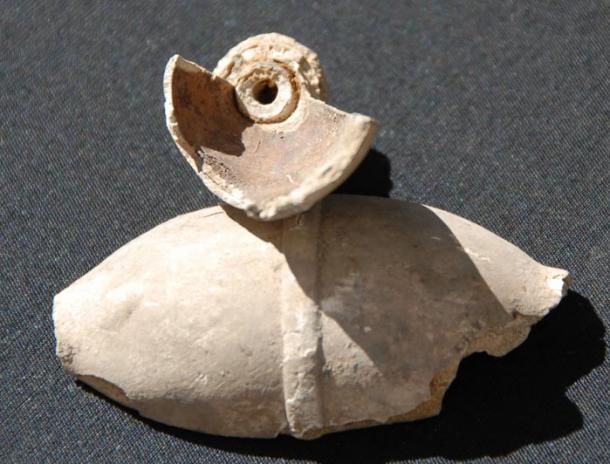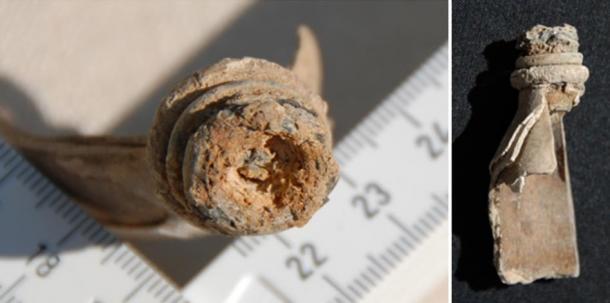It looks like you're using an Ad Blocker.
Please white-list or disable AboveTopSecret.com in your ad-blocking tool.
Thank you.
Some features of ATS will be disabled while you continue to use an ad-blocker.
7
share:
I just came across this in an article from
The Epoch Times that
popped a few minutes ago in my news feed but the original source is the website of what purports to be a
foundation engaged in the study of artifacts suggesting pre-Columbian contact with the indigenous peoples of the Americas. I don't know anything about
this organization but scanning their site, they do appear to have a certain focus on possible Chinese contact.
From Precontact.org:


Also alleged to have been found at the site are these interesting objects for which there are no details given beyond the following description:

One extremely concerning aspect of this story is that the person who reportedly found these artifacts — apparently starting with the kaolin piece found next to a ground hog's den on her own property — has a "professional background in art restoration, pottery and pigments." What are the odds of that? There's no mention of excavations being conducted by an independent archaeological team either. Finally, her name is withheld so there's no way to verify her credentials.
Hopefully more details about this alleged find are released because the pictures and story are certainly very interesting but without some independent confirmation, analysis of the artifacts, dating, etc these are just more entries in the long list of OOPArts with problematic provenance.
From Precontact.org:

An artifact recovered from a hilltop site overlooking the Delaware River in Eastern Pennsylvania, along with other artifacts recovered during a ten-year investigation reveals there is much to be learned about the history of the region.
The white Kaolin clay vessel serendipitously appeared one day in 2013 outside the entrance of a ground hog hole according to the property owner and researcher. With a professional background in art restoration, pottery and pigments, the type of clay and unique design features caught her attention as something atypical for the region.
As she explained, “Kaolin clay is quartz based and void of impurities, while Native American earthenware pottery used natural muds and pigments from their geographic vicinity” and that “pottery of the Delaware Indians produced a darker ceramic that was filled with natural impurities, such as grass and stones.” Also, the vessel's symmetrical shape may have been created in a mold, which differs from the coiling technique common to North American pottery.

Also alleged to have been found at the site are these interesting objects for which there are no details given beyond the following description:
[Left] 1.0 mm bas-relief star washed with translucent blue quartz pigment with reflective cartouche [Right] 4.7cm Copper artifact

One extremely concerning aspect of this story is that the person who reportedly found these artifacts — apparently starting with the kaolin piece found next to a ground hog's den on her own property — has a "professional background in art restoration, pottery and pigments." What are the odds of that? There's no mention of excavations being conducted by an independent archaeological team either. Finally, her name is withheld so there's no way to verify her credentials.
Hopefully more details about this alleged find are released because the pictures and story are certainly very interesting but without some independent confirmation, analysis of the artifacts, dating, etc these are just more entries in the long list of OOPArts with problematic provenance.
edit
on 2015-10-26 by theantediluvian because: (no reason given)
a reply to: theantediluvian
Very interesting. Thanks for posting this.
I think the layers that are visible in the one photo are especially interesting. I wonder if the object may have formed using a 'slip' technique, where an object is dipped in a thin mixture of the clay?
Very interesting. Thanks for posting this.
I think the layers that are visible in the one photo are especially interesting. I wonder if the object may have formed using a 'slip' technique, where an object is dipped in a thin mixture of the clay?
a reply to: theantediluvian
Maybe it was something like a Baghdad battery instead of a grenade. Maybe that's what the copper was for.
Maybe it was something like a Baghdad battery instead of a grenade. Maybe that's what the copper was for.
Perhaps it's old whistlepig trash.
Groundhogs are interesting fat little mammals.
Groundhogs are interesting fat little mammals.
Very interesting antidilluvian,
You can't rule out a native american source.
Just because the local pottery was different doesn't mean it not NA.
Its a well established fact that trade among NA 's was trans and inter continental.
Shell beads from coastal cal have been found in Kansas, Chihuahuas have been found in Arkansas, chert from Labrador has been found in Pennsylvania and Delaware, and that was 13,000 kya for that, Peruvian pottery has been found in southern Florida.
Items with a definitively meso american origin have been found all through the southern US.
If it was found in any of the major river drainages , it would for sure trade pieces.
There are tribes in the western central US that use kaolin for their ceramics.
Bas relief carving has a long history in the SE , going all the way back to the Clovis.
But the fact the finder just happens to be a ceramics expert , and won't release here name throws up a craps load of red flags.
By the way people , if not an out right hoax , this is the definition of an oopart.
An item out of place, but not out of touch with reality.
You can't rule out a native american source.
Just because the local pottery was different doesn't mean it not NA.
Its a well established fact that trade among NA 's was trans and inter continental.
Shell beads from coastal cal have been found in Kansas, Chihuahuas have been found in Arkansas, chert from Labrador has been found in Pennsylvania and Delaware, and that was 13,000 kya for that, Peruvian pottery has been found in southern Florida.
Items with a definitively meso american origin have been found all through the southern US.
If it was found in any of the major river drainages , it would for sure trade pieces.
There are tribes in the western central US that use kaolin for their ceramics.
Bas relief carving has a long history in the SE , going all the way back to the Clovis.
But the fact the finder just happens to be a ceramics expert , and won't release here name throws up a craps load of red flags.
By the way people , if not an out right hoax , this is the definition of an oopart.
An item out of place, but not out of touch with reality.
originally posted by: punkinworks10
Very interesting antidilluvian,
You can't rule out a native american source.
I would quantify that as "you can't rule out a Native American source dated 1800 or later." A scenario where a Native American is working for a local potter and took a piece home and broke it and threw it away is quite plausible. A scenario where it was something from the local pharmacy (which is what that stopper reminds me of) that was bought and taken home and tossed when it was broken is also plausible. You might be able to make a case for the land once belonging to a potter who made specialty jars for local merchants (storing liquids or powders, etc.)
Its a well established fact that trade among NA 's was trans and inter continental.
Quite true. However, the chains changed with time and with alliances.
By the way people , if not an out right hoax , this is the definition of an oopart.
An item out of place, but not out of touch with reality.
I would hesitate to say it's an OOPART. I think it's of relatively recent manufacture, based on the design of the lip of the object and the stopper itself - they're not typical Chinese from the dynastic periods.
The person declaring it to be a possible Chinese artifact and possibly pre-Columbian is an anonymous artist (and property owner) and not an archaeologist specializing in Native American artifacts who's digging up an area.
And I personally find the "grenade"l label not very plausible, but that's just me.
new topics
-
WF Killer Patents & Secret Science Vol. 1 | Free Energy & Anti-Gravity Cover-Ups
General Conspiracies: 19 minutes ago -
Hurt my hip; should I go see a Doctor
General Chit Chat: 1 hours ago -
Israel attacking Iran again.
Middle East Issues: 2 hours ago -
Michigan school district cancels lesson on gender identity and pronouns after backlash
Education and Media: 2 hours ago -
When an Angel gets his or her wings
Religion, Faith, And Theology: 3 hours ago -
Comparing the theology of Paul and Hebrews
Religion, Faith, And Theology: 4 hours ago -
Pentagon acknowledges secret UFO project, the Kona Blue program | Vargas Reports
Aliens and UFOs: 5 hours ago -
Boston Dynamics say Farewell to Atlas
Science & Technology: 5 hours ago -
I hate dreaming
Rant: 5 hours ago -
Man sets himself on fire outside Donald Trump trial
Mainstream News: 7 hours ago
top topics
-
The Democrats Take Control the House - Look what happened while you were sleeping
US Political Madness: 8 hours ago, 18 flags -
In an Historic First, In N Out Burger Permanently Closes a Location
Mainstream News: 10 hours ago, 16 flags -
A man of the people
Medical Issues & Conspiracies: 15 hours ago, 11 flags -
Biden says little kids flip him the bird all the time.
Politicians & People: 7 hours ago, 8 flags -
Man sets himself on fire outside Donald Trump trial
Mainstream News: 7 hours ago, 7 flags -
Pentagon acknowledges secret UFO project, the Kona Blue program | Vargas Reports
Aliens and UFOs: 5 hours ago, 6 flags -
Israel attacking Iran again.
Middle East Issues: 2 hours ago, 5 flags -
Michigan school district cancels lesson on gender identity and pronouns after backlash
Education and Media: 2 hours ago, 4 flags -
4 plans of US elites to defeat Russia
New World Order: 17 hours ago, 4 flags -
Boston Dynamics say Farewell to Atlas
Science & Technology: 5 hours ago, 4 flags
active topics
-
Hurt my hip; should I go see a Doctor
General Chit Chat • 9 • : rickymouse -
Silent Moments --In Memory of Beloved Member TDDA
Short Stories • 48 • : Encia22 -
MULTIPLE SKYMASTER MESSAGES GOING OUT
World War Three • 52 • : cherokeetroy -
Israel attacking Iran again.
Middle East Issues • 22 • : Boomer1947 -
WF Killer Patents & Secret Science Vol. 1 | Free Energy & Anti-Gravity Cover-Ups
General Conspiracies • 1 • : WakeofPoseidon -
The Democrats Take Control the House - Look what happened while you were sleeping
US Political Madness • 67 • : WeMustCare -
Thousands Of Young Ukrainian Men Trying To Flee The Country To Avoid Conscription And The War
Other Current Events • 53 • : ghandalf -
Boston Dynamics say Farewell to Atlas
Science & Technology • 5 • : Caver78 -
Biden says little kids flip him the bird all the time.
Politicians & People • 16 • : stelth2 -
When an Angel gets his or her wings
Religion, Faith, And Theology • 2 • : stelth2
7
